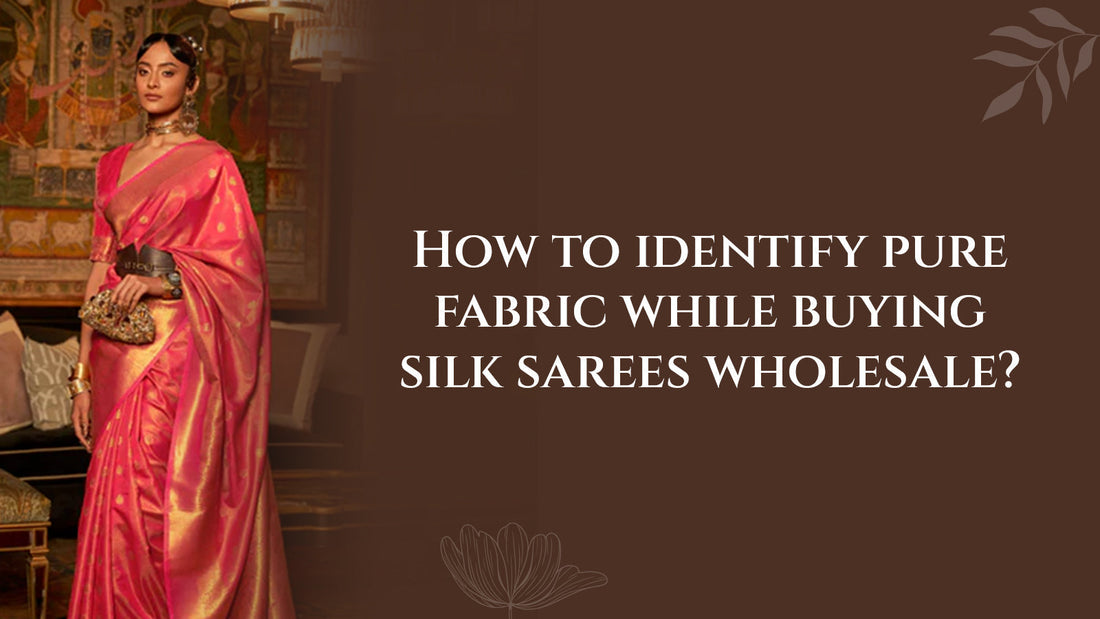
How to Identify Pure Fabric While Buying Silk Sarees Wholesale?
Silk sarees are one of the most loved garments in India. Their elegance, vibrant textures, and cultural richness make them a must-have in every wardrobe. When you're buying in bulk, especially at a saree wholesale rate, it becomes essential to ensure you're getting pure silk. Mixing or mislabeling can lead to losses, especially if you're reselling. So, how do you tell the difference?
Let’s break it down.
Why It’s Important to Identify Pure Silk in Wholesale Purchases
In wholesale, one wrong batch can cost you. Silk is often mixed with synthetic fibers and sold as pure. If you miss the difference, you might pass off fake silk to your customers, hurting your reputation. You’re not just buying a saree. You’re investing in quality. Pure silk reflects your brand value. It helps you build trust. And trust sells. Whether you're running a boutique or selling sarees online, identifying genuine silk ensures your business stays reliable and profitable.
Key Features to Identify Pure Silk Fabric
Here are practical ways to spot pure silk without needing a lab. These are especially useful when you’re shopping in busy markets or showrooms.
A. Touch and Texture Test
Pure silk has a soft, warm, almost buttery feel. Rub the fabric between your fingers. It should feel warm quickly. Synthetic fabrics often feel cool or slippery, and they don’t warm up like silk. You can also scrunch a part of the saree in your hand. If it crunches lightly like walking on fresh snow that’s a good sign. Fake silks don’t sound the same.
B. The Luster Test
Pure silk reflects light uniquely. It has a soft, multi-tonal sheen. Tilt the fabric under light. Real silk shows different tones when viewed at various angles. Synthetic versions shine bright but look flat in tone. This natural shine is especially noticeable in printed silk sarees.
C. Burn Test (Only in Small Samples)
If you're allowed a sample or if you’re dealing with scraps the burn test works well.
Burn a few loose threads:
- Pure silk burns slowly and smells like burnt hair.
- It leaves behind a black, crispy ash.
- Synthetic silk melts and smells like plastic.
- The residue is stiff and shiny.
Don’t perform this test on full sarees. It’s only for small cuttings and only when you’re permitted.
D. Weave and Imperfections
Silk is handwoven or crafted with care. This often leads to minor inconsistencies and that’s a good thing. Look at the weave. Tiny slubs (uneven threads) show it’s handmade. Machine-made synthetics are too smooth, too perfect. Look for richness in texture. Pure silk has a depth that cheap blends lack.
E. The Ring Test
This one's fun. Take a silk saree and try pulling it through a small ring (like a finger ring). Pure silk excellent varieties glides through with ease. Synthetics or mixed fabrics feel bulky or get stuck.
F. Price vs. Value Check
If it sounds too good to be true, it probably is. Pure silk is not cheap, not even at a saree wholesale rate. Yes, wholesale cuts down margins. But be alert if someone offers 100% silk at prices that rival synthetic materials. That doesn’t mean you need to overspend. Just know what real silk is worth.
Questions to Ask Your Wholesaler
Buying wholesale means you’re trusting someone to supply your business. Don’t hesitate to ask questions.
1. What kind of silk is this?
Mulberry, Tussar, Eri, or Muga? Each has its traits.
2. Is this a handloom or power loom?
Handloom silk has more authenticity, texture, and is valued more.
3. Can I see a test report or certification?
Suppliers dealing in bulk usually have silk purity tests available. Look for Silk Mark tags or other authentic certifications.
4. Where is this sourced from?
Knowing the region helps Kanchipuram, Banaras, Assam different places, different silks.
5. Do you allow fabric sample testing?
If they’re confident about their product, they won’t hesitate.
6. What’s your return or replacement policy?
Especially important when you're buying in bulk.
Your wholesaler should be open and transparent. If they dodge questions, move on.
Styling Tip: Add Value for Your Customers
Once you’ve confirmed fabric authenticity, think about how you present the sarees. Customers love variety. Offer a range from full-sleeved kurta set combinations for blouse pairings to modern draping ideas. Packaging also matters. A beautiful saree folded in a cheap plastic bag kills the vibe. Wrap it well. Add care instructions. Give your customer a reason to remember you. If you’re selling buy sarees online collections, use clear, detailed images and videos to show fabric movement and texture. Let the quality speak through the screen.
Why Printed Silk Sarees Are in Demand
Printed silks are lightweight, trendy, and easy to carry. Customers love them for everyday wear, work events, or even casual weddings. Wholesale buyers prefer them because they’re:
- Easy to store
- Quick to sell
- Available in bulk
- More affordable than heavy embroidery
But again, prints can hide fake silk. Always test before you trust.
Conclusion
You’re not just selling a saree. You’re selling trust. When customers wear your product, they expect comfort, elegance, and quality. Make sure they get all three. Don’t rush through bulk deals. Take your time. Use the tips above. Ask questions. Touch. Feel. Compare. The more you learn about silk, the more confident you’ll be in your buying decisions.
Visit our Instagram Page and explore a trusted selection of pure silk sarees latest offer and to know what's new on our website . At Roop Mohini, every fabric tells a story.

